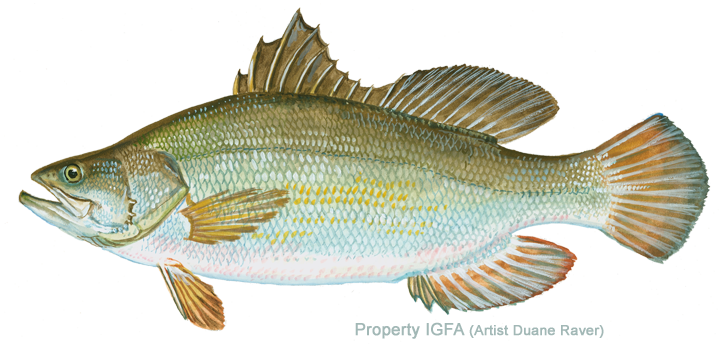Game Fish Identification Reference Guides
Barramundi
(Lates calcarifer)
(Lates calcarifer)

(Bloch, 1792); LATIDAE FAMILY; also called silver barramundi, giant perch, palmer, cock up, barra, anama (indigenous name, Port Moresby)
The barramundi occurs from northern Australia (primarily north of the Tropic of Capricorn, but rarely as far south as the Maroochy River) to the Philippines and southern China and around the coasts of India to the Persian Gulf. It is a catadromous fish, growing to maturity in fresh water and moving downstream with the onset of the summer monsoon season in October to spawn on the mud flats and in the mouths of estuaries in water of about 2 to 3 percent salinity.
The barramundi is a distinctive fish that bears a noticeable resemblance to its relative the snook, (Centropomus undecimalis). It is also closely related to the huge Nile perch, (Lates niloticus). One of its most noticeable characteristics is its startling pinkish red eyes, which glow brilliantly at night and even reflect in sunlight. The sides are silvery and the back has a greenish gray tint. The maxillae of the huge mouth extend back beyond the eyes. The head is relatively long and flattened on top.
The barramundi's gill flaps are particularly sharp edged and will slice through fishing line and nets readily. The two dorsal fins are set close together. The tail is more or less rounded. The lateral line is a highly developed sensory organ in the barramundi that can detect vibrations in the water. Consequently, some anglers suggest that a lure should “swim” through the water with an action resembling that of a wounded fish. This creates a vibration that the barramundi can detect and identify.
Live mullets, minnows, barra frogs, and prawns are the barramundi's natural prey and the best live baits; but artificial lures can be deadly at times. Trolling along the banks is probably the most popular fishing method, but by casting from shore, an angler can work in among the snags and brush where barramundi hide and where a trolled lure won't reach..
Barramundi are hermaphrodites; they start life as males, then transform into females after about the second year.
The barramundi is an excellent food fish, reported to be “of gourmet quality.
The barramundi occurs from northern Australia (primarily north of the Tropic of Capricorn, but rarely as far south as the Maroochy River) to the Philippines and southern China and around the coasts of India to the Persian Gulf. It is a catadromous fish, growing to maturity in fresh water and moving downstream with the onset of the summer monsoon season in October to spawn on the mud flats and in the mouths of estuaries in water of about 2 to 3 percent salinity.
The barramundi is a distinctive fish that bears a noticeable resemblance to its relative the snook, (Centropomus undecimalis). It is also closely related to the huge Nile perch, (Lates niloticus). One of its most noticeable characteristics is its startling pinkish red eyes, which glow brilliantly at night and even reflect in sunlight. The sides are silvery and the back has a greenish gray tint. The maxillae of the huge mouth extend back beyond the eyes. The head is relatively long and flattened on top.
The barramundi's gill flaps are particularly sharp edged and will slice through fishing line and nets readily. The two dorsal fins are set close together. The tail is more or less rounded. The lateral line is a highly developed sensory organ in the barramundi that can detect vibrations in the water. Consequently, some anglers suggest that a lure should “swim” through the water with an action resembling that of a wounded fish. This creates a vibration that the barramundi can detect and identify.
Live mullets, minnows, barra frogs, and prawns are the barramundi's natural prey and the best live baits; but artificial lures can be deadly at times. Trolling along the banks is probably the most popular fishing method, but by casting from shore, an angler can work in among the snags and brush where barramundi hide and where a trolled lure won't reach..
Barramundi are hermaphrodites; they start life as males, then transform into females after about the second year.
The barramundi is an excellent food fish, reported to be “of gourmet quality.













